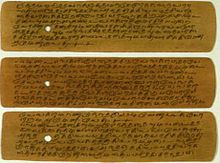
A manuscript was, traditionally, any document written by hand or typewritten, as opposed to mechanically printed or reproduced in some indirect or automated way. More recently, the term has come to be understood to further include any written, typed, or word-processed copy of an author's work, as distinguished from the rendition as a printed version of the same.
The Pāli Text Society is a text publication society founded in 1881 by Thomas William Rhys Davids "to foster and promote the study of Pāli texts." Pāli is the language in which the texts of the Theravada school of Buddhism are preserved. The Pāli texts are the oldest collection of Buddhist scriptures preserved in the language in which they were written down. The society first compiled, edited, and published Latin script versions of a large corpus of Pāli literature, including the Pāli Canon, as well as commentarial, exegetical texts, and histories. It publishes translations of many Pāli texts. It also publishes ancillary works including dictionaries, concordances, books for students of Pāli and the Journal of the Pali Text Society.
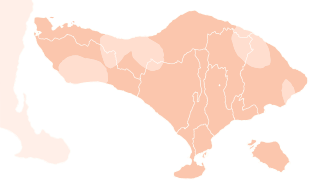
Balinese is a Malayo-Polynesian language spoken on the Indonesian island of Bali, as well as Northern Nusa Penida, Western Lombok, Eastern Java, Southern Sumatra, and Sulawesi. Most Balinese speakers also use Indonesian. The 2000 national census recorded 3.3 million people speakers of Balinese, however the Bali Cultural Agency estimated in 2011 that the number of people still using the Balinese language in their daily lives is under 1 million. The language has been classified as "not endangered" by Glottolog.
The Odia script is a Brahmic script used to write primarily Odia language and others including Sanskrit and other regional languages. It is one of the official scripts of the Indian Republic. The script has developed over more than 1000 years from a variant of Siddhaṃ script which was used in Eastern India, where the characteristic top line transformed into a distinct round umbrella shape due to the influence of palm leaf manuscripts and also being influenced by the neighbouring scripts from the Western and Southern regions.
Indian literature refers to the literature produced on the Indian subcontinent until 1947 and in the Republic of India thereafter. The Eighth Schedule to the Constitution of India has 22 officially recognised languages. Sahitya Akademi, India's highest literary body, also has 24 recognised literary languages.
The Javanese script is one of Indonesia's traditional scripts developed on the island of Java. The script is primarily used to write the Javanese language, but in the course of its development has also been used to write several other regional languages such as Sundanese, Madurese, and Sasak; the lingua franca of the region, Malay; as well as the historical languages Kawi and Sanskrit. Javanese script was actively used by the Javanese people for writing day-to-day and literary texts from at least the mid-15th century CE until the mid-20th century CE, before its function was gradually supplanted by the Latin alphabet. Today the script is taught in DI Yogyakarta, Central Java, and the East Java Province as part of the local curriculum, but with very limited function in everyday use.
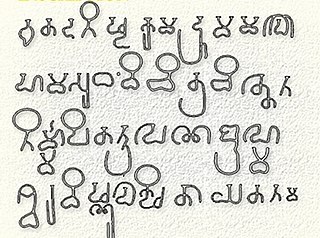
The Grantha script was a classical South Indian Brahmic script, found particularly in Tamil Nadu and Kerala. Originating from the Pallava script, the Grantha script is related to Tamil and Vatteluttu scripts. The modern Malayalam script of Kerala is a direct descendant of the Grantha script. The Southeast Asian and Indonesian scripts such as Thai and Javanese respectively, as well as South Asian Tigalari and Sinhala scripts, are derived or closely related to Grantha through the early Pallava script. The Pallava script or Pallava Grantha, emerged in the 4th century CE and was used until the 7th century CE, in India. This early Grantha script was used to write Sanskrit texts, inscriptions on copper plates and stones of Hindu temples and monasteries. It was also used for classical Manipravalam – a language that is a blend of Sanskrit and Tamil. From it evolved Middle Grantha by the 7th century, and Transitional Grantha by about the 8th century, which remained in use until about the 14th century. Modern Grantha has been in use since the 14th century and into the modern era, to write classical texts in Sanskrit and Dravidian languages. It is also used to chant hymns and in traditional Vedic schools.

Jayadeva, also spelt Jaideva, was a Sanskrit poet during the 12th century. He is most known for his epic poem Gita Govinda which concentrates on Krishna's love with the gopi, Radha, in a rite of spring. This poem, which presents the view that Radha is greater than Krishna, is considered an important text in the Bhakti movement of Hinduism.

Birch bark manuscripts are documents written on pieces of the inner layer of birch bark, which was commonly used for writing before the mass production of paper. Evidence of birch bark for writing goes back many centuries and appears in various cultures. The oldest such manuscripts are the numerous Gandhāran Buddhist texts from approximately the 1st century CE, from what is now Afghanistan. They contain among the earliest known versions of significant Buddhist scriptures, including a Dhammapada, discourses of Buddha that include the Rhinoceros Sutra, Avadanas and Abhidharma texts.

A Hindu temple, also known as Mandir, Devasthanam, Pura, or Koil, is a sacred place where Hindus worship and show their devotion to deities through worship, sacrifice, and devotion. It is considered the house of the god to whom it is dedicated. The design, structure and symbolism of Hindu temples are deeply rooted in Vedic traditions, which use circles and squares in their architecture. The temple's design also represents the concept of recursion and the equivalence of the macrocosm and the microcosm through astronomical numbers and specific alignments related to the location of the temple and the connection between the deity and the worshipper. A temple incorporates all elements of the Hindu cosmos — presenting the good, the evil and the human, as well as the elements of the Hindu sense of cyclic time and the essence of life — symbolically presenting dharma, artha, kama, moksha, and karma.

Singaraja is a port town in northern Bali, Indonesia, which serves as the seat of Buleleng Regency. The name is Indonesian for "Lion King". It is just east of Lovina and is also the centre of Buleleng District, which covers an area of 46.94 km² and had a population of 153,930 in 2022, the second largest on the island.

Saraswathi Mahal Library, also called Thanjavur Maharaja Serfoji's Saraswathi Mahal Library is a library located in Thanjavur (Tanjore), Tamil Nadu, India. It is one of the oldest libraries in Asia established during 16th century by Nayakar kings of Thanjavur and has on display a rare collection of Palm leaf manuscripts and paper written in Tamil and Sanskrit and a few other indigenous languages of india. The collection comprises well over 49,000 volumes, though only a tiny fraction of these are on display. The library has a complete catalog of holdings, which is being made available online. Some rare holdings can be viewed on site by prior arrangement. Encyclopedia Britannica mentions the library as the "Most remarkable library of India".

Tigalari, also known as Tulu script, is a Southern Brahmic script which was used to write Tulu, Kannada, and Sanskrit languages. It was primarily used for writing Vedic texts in Sanskrit. It evolved from the Grantha script. It is called as Tigalari lipi in Kannada-speaking regions and Tulu speakers call it as Tulu lipi. It bears high similarity and relationship to its sister script Malayalam, which also evolved from the Grantha script.

The Skanda Purana is the largest Mukhyapurana, a genre of eighteen Hindu religious texts. The text contains over 81,000 verses, and is of Shaivite literature, titled after Skanda, a son of Shiva and Parvati. While the text is named after Skanda, he does not feature either more or less prominently in this text than in other Shiva-related Puranas. The text has been an important historical record and influence on the Hindu traditions and rituals related to the war-god Skanda.
The Ten Idylls, known as Pattuppāṭṭu or Ten Lays, is an anthology of ten longer poems in the Sangam literature – the earliest known Tamil literature. They range between about 100 and 800 lines, and the collection includes the celebrated Nakkīrar's Tirumurukāṟṟuppaṭai. The collection was termed as "Ten Idylls" during the colonial era, though this title is considered "very incorrect" by Kamil Zvelebil – a scholar of Tamil literature and history. He suggests "Ten Lays" as the more apt title. Five of these ten ancient poems are lyrical, narrative bardic guides (arruppatai) by which poets directed other bards to the patrons of arts such as kings and chieftains. The others are guides to religious devotion (Murugan) and to major towns, sometimes mixed with akam- or puram-genre poetry.
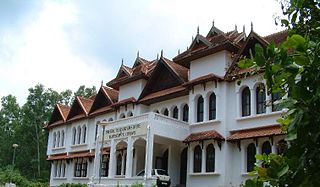
The Oriental Research Institute & Manuscripts Library, University of Kerala, is one of the leading centres of Indology in India. It is located at Kariavattom, Thiruvananthapuram, Kerala. The institute carry out researches on Indian language manuscripts, about 80% of which are in Sanskrit. The department is microfilming the manuscripts of certain technical subjects.
Indian copper plate inscriptions are historical legal records engraved on copper plates in the Indian subcontinent.
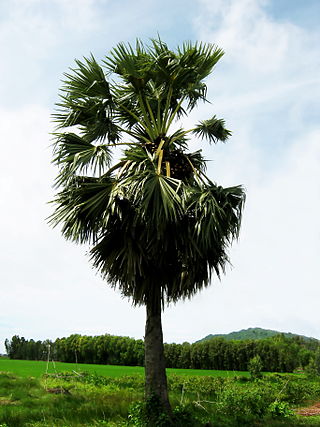
Borassus flabellifer, commonly known as doub palm, palmyra palm, tala or tal palm, toddy palm, lontar palm, wine palm, ထန်းပင် (htan-pin) or ice apple, is a fan palm native to South Asia and Southeast Asia. It is reportedly naturalized in Socotra and parts of China.

Siddhaṃ, also known in its later evolved form as Siddhamātṛkā, is a medieval Brahmic abugida, derived from the Gupta script and ancestral to the Nāgarī, Eastern Nagari, Tirhuta, Odia and Nepalese scripts.
Pecha is a Tibetan word meaning "book", but in particular, refers to the traditional Tibetan loose-leaf books such as the kangyur, tengyur, and sadhanas. Pechas sometimes have top and bottom cover plates made of wood, cardboard, or other firm materials, and are often seen wrapped in cloth for protection. The word pecha has entered common use in other languages such as English in the Tibetan Buddhist community, evident online in discussion forums and software products that include the word in their names.









